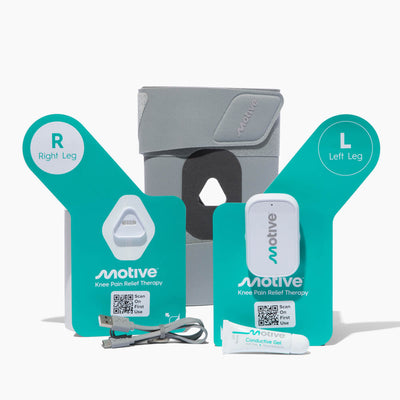
Sleeping after knee replacement surgery is no joke. Between the pain, swelling, and stiffness, getting comfortable can feel like a losing battle.
But quality rest is exactly what your body needs to bounce back and heal fully.
Knee replacement surgery is a life-changing procedure that brings tremendous relief from chronic pain and improved mobility in the long run. However, the immediate recovery period presents unique challenges, especially when it comes to sleep.
According to recent studies, nearly 50% of patients report “severe” sleep disturbances after joint replacement surgery, making it one of the most common complaints during the knee recovery journey.
Finding the right sleeping position after knee replacement isn’t just about comfort; it also plays a crucial role in your healing process and can impact your recovery time.
This guide will walk you through the best ways to sleep after knee replacement, with practical tips to maximize comfort while protecting your new knee.
Common Sleep Challenges Post-Knee Replacement
The path to better sleep after knee surgery starts with understanding what’s keeping you awake in the first place.
-
Post-Operative Pain and Discomfort: The surgery site hurts and gets worse when you try to fall asleep and stay asleep. Without the distractions of daytime activities, pain signals can seem louder at night.
-
Swelling and Inflammation: Even with proper medication, inflammation around the knee joint makes finding a comfortable position almost impossible. Elevation is key, but hard to maintain for a good night’s sleep.
-
Limited Mobility and Stiffness: Your ability to adjust positions naturally during sleep is severely limited after knee replacement. This limitation leads to stiffness, discomfort, and disrupted sleep cycles.
-
Anxiety and Worry About the New Knee: Many patients worry about damaging their new knee while sleeping, making it harder to fall asleep naturally due to being in a state of anxiety.
The combination of these factors explains why poor sleep is so common after surgery. But specific sleeping positions and strategies can help following your knee surgery and provide more knee pain relief.
The Best Ways to Sleep After Knee Replacement
Choosing the best position with proper support for your knee is your first line of defense against sleepless nights, so you can have a smooth recovery.
Sleeping on Your Back (The Generally Preferred Method)
Supine positioning (lying on your back) is the recommended position for sleep after knee replacement.
This position allows for optimal alignment of your hips and legs and minimizes stress on your new knee.
To make this position comfortable, incorporate these few tips:
-
Elevate your operated leg with pillows from your ankle to your thigh. This elevation reduces swelling and pain by promoting proper blood flow away from the surgical site.
-
Keep your leg straight or slightly bent at the knee, exactly as your surgeon instructed. Most recovery protocols for knee replacement surgery published by major orthopedic centers recommend keeping the leg in extension (straight) during rest periods.
-
Support your lower back with a thin pillow to maintain spinal alignment. This prevents additional strain that can affect your ability to sleep.
Many patients find that a specialized wedge pillow provides more consistent elevation than standard pillows, which can shift during sleep.
Sleeping on Your Non-Operated Side (With Strict Precautions)
As you progress in your recovery process, you may start to sleep on your non-operative side, but this should only be done with caution.
When you start sleeping on your side:
-
Always place a firm pillow between your knees to prevent the operated knee from crossing the midline or rotating inward. This pillow acts as a spacer to maintain hip and knee alignment.
-
Position additional pillows behind your back to prevent rolling onto your back or the operated side during sleep.
-
Elevate your operated leg with the pillow between your legs to promote healing and reduce swelling.
Note: Side sleeping is usually an option several weeks into recovery, not immediately after surgery. Always check with your physical therapist or surgeon before trying this position.
Positions to Absolutely Avoid
Some sleeping positions can hinder your healing and should be avoided after knee replacement:
-
Sleeping on your stomach puts significant rotational forces on your new knee joint and can strain your back and hips. This position makes it impossible to maintain proper alignment of your operated knee.
-
Sleeping directly on your operated side puts pressure on the surgical site and can disrupt healing tissues. This position should be avoided until cleared by your healthcare provider.
-
Any position that bends your operated knee beyond recommended ranges can compromise your recovery. Most surgeons recommend extending the knee (straight) during rest periods.
Essential Tips for Maximizing Sleep Comfort and Safety
Beyond position, there are several ways to sleep better during the recovery period.
Elevating Your Operated Leg Consistently
Elevation isn’t just for sleeping. Do this whenever you’re in bed or sitting to reduce swelling throughout the day. Ideally, your knee should be above your heart to maximize fluid drainage and reduce pain.
The science behind elevation shows that consistent elevation of the affected limb reduces inflammation biomarkers and improves tissue oxygenation, which are both key to joint recovery.
Using Pillows Strategically
Pillows are your best friend for support during sleep after knee replacement. Use them to:
-
Support your operated leg
-
Separate your knees when side sleeping
-
Support your back
-
Create barriers to prevent rolling into painful positions
A wedge pillow designed for leg elevation is more supportive than regular pillows that compress or shift during the night.
Managing Pain Effectively
Take your prescribed pain medication as directed, especially before bed. Many surgeons recommend timing your pain management to optimize coverage during sleeping hours.
Additional ways to relieve pain before sleep include:
-
Applying ice packs (as recommended by your doctor)
-
Gentle exercises approved by your physical therapist
-
Relaxation techniques to reduce muscle tension
Creating a Comfortable Sleep Environment
Your sleep environment has a big impact on your ability to sleep comfortably after surgery and can also affect your overall sleep quality. To create a good environment to sleep properly:
-
Keep the room comfortable (slightly cooler rooms promote better sleep)
-
No bright lights or electronic screens for at least an hour before bed
-
Use blackout curtains if needed to create total darkness
-
Consider white noise to mask any noise
-
Ensure you have a comfortable temperature in your room
Establish a Relaxing Bedtime Routine
Creating a consistent pre-sleep routine tells your body it’s time to rest:
-
Do gentle relaxation activities like reading or listening to calming music
-
Practice deep breathing or guided meditation for pain management
-
Limit liquids close to bedtime to reduce nighttime bathroom trips
-
Use sleep aids only as directed by your medical team
Many patients find that specialized knee treatments applied before bed as part of their routine can provide extra comfort to help them fall asleep faster.
The Importance of Following Medical Guidance
While this article provides general tips for sleeping after knee replacement, everyone’s recovery is different. Your surgical team should develop specific protocols for your individual case, surgical technique, and health status.
Follow your surgeon’s specific instructions for:
-
Sleeping positions
-
Range of motion
-
Weight-bearing restrictions that impact positioning
-
Post-op equipment like CPM machines
Be open with your doctor and physical therapy team about any sleep problems you encounter. Bring up sleep issues at your follow-up appointments; they may adjust your pain management or physical therapy to help with ongoing sleep issues.
Prioritize Rest for a Successful Recovery
Sleep directly correlates with faster healing, fewer complications, and better outcomes after knee replacement surgery. Your body does repair work during deep sleep phases that can’t be replicated during the day.
As hard as it may be to find comfort at first, most patients find their sleep gets better as they recover. Be patient with the process and consistent with these strategies, and you’ll get through the tricky part of finding comfortable positions to rest.
Remember, rehabilitation isn’t just about daytime exercises. Rest is always just as important a part of your recovery journey. Motive Knee's muscle-strengthening therapy can help you recover more effectively by targeting and fortifying the key muscles surrounding your knee joint.
By following these strategies and working with your healthcare team, you’ll develop a personalized approach to sleep that suits your recovery needs. With time and care, your knee function and sleep will improve, and you’ll be back to the pain-free life you had before your joint replacement surgery.
Get started with Motive today to begin your journey!





